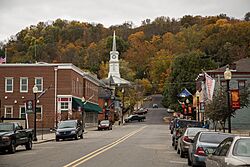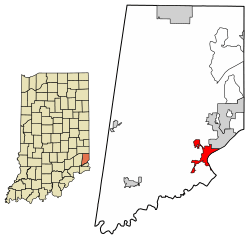Aurora, Indiana facts for kids
Quick facts for kids
Aurora, Indiana
|
||
|---|---|---|
 |
||
|
||
| Nickname(s):
City of Spires
|
||

Location of Aurora in Dearborn County, Indiana.
|
||
| Country | United States | |
| State | Indiana | |
| County | Dearborn | |
| Township | Center | |
| Platted | 1819 | |
| Incorporated | 1848 | |
| Area | ||
| • Total | 3.54 sq mi (9.16 km2) | |
| • Land | 3.29 sq mi (8.53 km2) | |
| • Water | 0.24 sq mi (0.63 km2) | |
| Elevation | 515 ft (157 m) | |
| Population
(2020)
|
||
| • Total | 3,479 | |
| • Density | 1,056.80/sq mi (408.05/km2) | |
| Time zone | UTC-5 (EST) | |
| • Summer (DST) | UTC-4 (EDT) | |
| ZIP code |
47001
|
|
| Area code | 812 | |
| FIPS code | 18-02782 | |
| GNIS ID | 2394030 | |
Aurora is a city in Dearborn County, Indiana, United States. It is located in Center Township. In 2020, about 3,479 people lived there.
Contents
Where is Aurora Located?
Aurora is a city in Indiana. It covers about 3.5 square miles (9.16 square kilometers). Most of this area is land, with a small part being water.
Aurora's History
Aurora was first planned out in 1819. It was named after Aurora, the Roman goddess of dawn. The city officially became a city in 1848.
Historic Buildings in Aurora
Aurora is famous for its old downtown area. It also has the beautiful Hillforest mansion. This mansion was built in 1855 for Thomas Gaff. He made his money by shipping goods on the Ohio River using steamboats.
The Hillforest mansion was designed in the Italian Renaissance style. It has a balanced look with deep roof overhangs, arched windows, and balconies. In 1992, Hillforest was named a National Historic Landmark. This means it is a very important historical place.
Many other buildings in Aurora are also listed on the National Register of Historic Places. These include the Aurora City Hall, the Aurora Public Library, and several historic churches. The George Street Bridge is also on this list.
People of Aurora
| Historical population | |||
|---|---|---|---|
| Census | Pop. | %± | |
| 1850 | 1,954 | — | |
| 1860 | 2,990 | 53.0% | |
| 1870 | 3,304 | 10.5% | |
| 1880 | 4,435 | 34.2% | |
| 1890 | 3,929 | −11.4% | |
| 1900 | 3,645 | −7.2% | |
| 1910 | 4,410 | 21.0% | |
| 1920 | 4,299 | −2.5% | |
| 1930 | 4,386 | 2.0% | |
| 1940 | 4,828 | 10.1% | |
| 1950 | 4,780 | −1.0% | |
| 1960 | 4,119 | −13.8% | |
| 1970 | 4,293 | 4.2% | |
| 1980 | 3,816 | −11.1% | |
| 1990 | 3,825 | 0.2% | |
| 2000 | 3,965 | 3.7% | |
| 2010 | 3,750 | −5.4% | |
| 2020 | 3,479 | −7.2% | |
| U.S. Decennial Census | |||
In 2010, there were 3,750 people living in Aurora. The average age of people in the city was about 36 years old. About 26% of the residents were under 18 years old.
Education in Aurora
Aurora has a free library for everyone to use. It is called the Aurora Public Library District.
Local Newspapers
- The Peoples' Advocate (1868–1870)
- The Aurora Journal (1859–1952)
Famous People from Aurora
Many interesting people have connections to Aurora:
- Kirtley Baker (1869–1927) – A professional baseball player.
- Stephen Bechtel Sr. (1900–1989) – He used to be the head of a big construction company called Bechtel Corporation.
- Elmer Davis (1890–1958) – He led the Office of War Information during World War II. He also won an award for his work.
- Elias Selah Holliday (1842–1936) – He served four terms in the United States House of Representatives.
- Jesse Lynch Holman (1774–1842) – He helped plan the city of Aurora in 1819. He was also a judge.
- William S. Holman (1822–1897) – Born in Aurora, he was elected to the United States House of Representatives ten times.
- Lonnie Mack (1941–2016) – A very important rock guitar player. He was born and grew up in the area.
- Anna Meyer (Born 1928) – At age 15, she was one of the youngest players to join the All-American Girls Professional Baseball League.
- Harry Emerson Rowbottom (1884–1934) – He served three terms in the United States House of Representatives.
- John Q. Tufts (1840–1902) – Born in Aurora, he later moved to Iowa and was elected to the United States House of Representatives.
See also
 In Spanish: Aurora (Indiana) para niños
In Spanish: Aurora (Indiana) para niños


